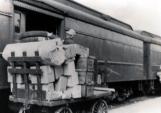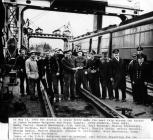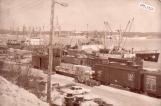27
TRAIN FERRIES CREATED WORK- There were 44,950 railway cars transported across the Strait of Canso in 1922 and by 1948, there were 116,585. This meant that on either side of the Strait, siding tracks were used to break up the trains, switch, sort and remake them before continuing either towards Sydney on Cape Breton Island or to western Canadian cities.In 1953, they were estimating that by 1960, there would be 145,000 railway cars crossing the Strait. (Dept. of Mines and Technical Surveys Geographical Bulletin,No.3, 1953)
29
The railway provided hundreds of jobs for men in the Strait Area, both directly and indirectly. These jobs included working on the trains themselves, such as brakemen, firemen, and engineers, freight and passenger agents in the towns along the line, baggage inspectors and station masters in all the rail stations. Added to this were the men on the train ferries running between Point Tupper and Mulgrave, many of whom lived in one of the two communities. Railway earned money drove the economy of the area for many years.Among the workers in the freight shed in Point Tupper in this picture is a freight handler, a mate from the Scotia II rail ferry, two car inspectors and a worker at the Port Hawkesbury Marine Railway, a business that serviced area vessels.
30
Railway buildings and engine on turntable.1950
Point Tupper, Richmond County, Nova Scotia, Canada

31
RAIL YARD AND DOCK - The Point Tupper rail yard was the entry point for all rail traffic to Cape Breton Island. The top picture, c. 1950, is a view of the yard from atop the roundhouse - that is, the building where locomotives were stored and serviced. In the top photo, the buildings of the rail yard can be seen. At the left is the double house, where the families of the station agent and the roundhouse foreman would live. In the centre is the tank that provided water for the steam engines. Behind that is the sand house and the coal shed. Sand was used on the tracks to provide traction. The Point Tupper Canadian National train station can be seen to the far right in the distance. Port Hawkesbury is in the background. The top of the turntable can be seen in the immediate foreground of the photo. Pictured at bottom is a locomotive on the turntable in front of the roundhouse. This allowed all locomotives to approach the roundhouse on the same track, and be shuffled to one of the several tracks inside the roundhouse bays.33
EVERYTHING CAME BY RAIL - A rail link to not only Cape Breton Island, but up into Inverness County, meant that items that were previously very rare, such as tropical fruit or some manufactured goods were now available. Allister W.D. MacBean, in his book "The Inverness and Richmond Railway", discussed freight shipments into the Strait Area."The inward express business was always heavy. Fruit, ice cream, bread, booze for the legal vendor (20 to 30 cases at a time plus barrels of bottled beer), mail order shipments from the T. Eaton Co. Ltd. of Toronto, Ont. and later from Moncton, N.B., et cetera. The car was shared with the baggage and at times there were numerous travellers, large sample cases, as well as cans of milk and other baggage items... Some bright customer of Eaton's got the idea of sending in an order C.O.D. In no time others caught on. Then Saturday afternoon (pay day at the mines) was a busy time in the express office, as the mine employees came in to pick up their orders from Eaton's. Monday the Express agent would be busy making out money orders, as a separate settlement had to be made for each shipment. In the early days, quite often the commission from the Canadian Express Company exceeded the salary from the railway."
In this picture from the early 1950s, a CN baggage handler unloads freight shipped into the Strait Area. Among the items received in this shipments are tires and crates of bananas. Some freight would have been transported by truck to areas not served by the railway.
36
CRANES - The Point Tupper rail yard said good bye to steam in 1954 when its last steam driven crane was retired. The crane pictured is set up for driving steel pilings. This and similar cranes could be dispatched by rail to points along the line that needed maintenance or where a derailment had occurred. One locomotive, Number 79, derailed more than once on the Point Tupper to Inverness rail line.In the background, the pilot house of the Scotia II rail ferry can be seen. Except in cases where locomotives needed to be brought to and from Cape Breton Island, it was only rail cars that were transported on the ferries. The railways on the island had their own locomotives and would receive the cars and transport them. The Inverness Railway and Coal Company operated only on Cape Breton Island and the Canadian National line to Sydney was serviced by a number of locomotives dedicated to that line.






